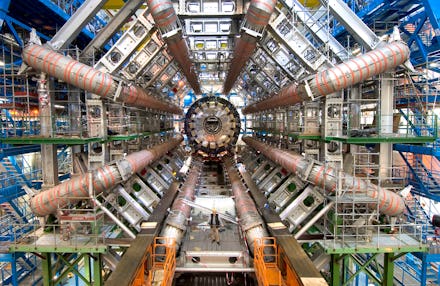Scientists Just Turned On the Biggest Machine in the World to Unlock the Big Bang

Scientists just embarked on one of the most important experiments of all time. They've turned on the Large Hadron Collider after a two-year rebuild and upgrade hiatus in an emboldened attempt to seek dark matter and get them closer to unlocking the unseen secrets of the universe — including dimensions of space we didn't know existed.
The LHC, first used in 2008, is a giant particle accelerator that, in 2012, led physicists to discover what they suggest is the Higgs boson, the most fundamental subatomic particle supposedly responsible for all the mass in the universe.
The machine is like something Stan Lee would give to a Samuel L. Jackson character. It's gargantuan, lives 328 feet beneath the French-Swiss border at the European Organization for Nuclear Research (CERN) and carries the potential for universe-collapsing catastrophe. Its point of existence is, in the simplest sense, to recreate the energy levels and environmental conditions that led to the Big Bang.
In the most dramatic sense, it's to reveal the secrets of the universe.
This time around, the LHC has been rebuilt to handle stronger collisions and smack proton beams into each other harder than ever before, hopefully getting researchers closer to proving what's thus far been impossible to prove.
The LHC fires beams of protons and ions at each other at nearly the speed of light, hoping high-energy particle crashes will let scientists finally see actual dark matter, a main focus of the LHC experiments.
The second wave of the LHC, affectionately dubbed Season 2 by CERN, plans to focus on the Brout-Englert-Higgs mechanism, dark matter, antimatter and quark-gluon plasma — all elements that were allegedly present in the few millionths of a second after the Big Bang.
According to NASA, 26.8% of the universe is made of dark matter, which can't be seen, and is only known to exist because something besides detectable matter is having an effect on gravity and making the universe expand. Dark matter's sister, dark energy, makes up a whopping 68.3% of the universe, which leaves normal matter — Earth, the planets, anything scientists have actually observed — at only 5% of the known universe. The main question the LHC would help answer is what that other 95% does and what it tells us about existence as we know it.
"After the discovery of the Higgs boson in 2012 by the ATLAS and CMS collaborations," said a statement from the CERN Press Office, according to NPR, "physicists will be putting the Standard Model of particle physics to its most stringent test yet, searching for new physics beyond this well-established theory describing particles and their interactions."
The difficult part about explaining the LHC is that it's a research tool, used to simulate actual phenomena happening in the galaxy — and since it deals with complex topics, the breakthroughs can be difficult to understand. When CERN published a press release that the Large Hadron Collider had discovered the existence of the Force from Star Wars, an alarming amount of people took it seriously — until the release started talking about CERN theorist Ben Kenobi of the University of Mos Isley.
But that's because the LHC is a magnificent, terrifying, unprecedented piece of science that could either catapult scientific research forward at an incredible rate or turn one of science's greatest minds into a loony doomsday prophet. That alone illustrates the baffling amount of cool that is the reboot of literally the largest machine in the world.